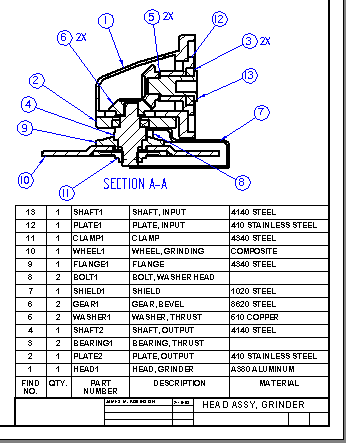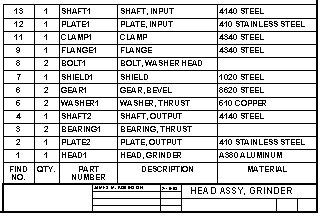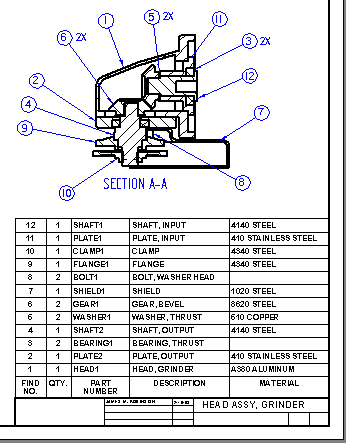Many companies include parts lists in their assembly drawings to give additional information about individual assembly components. For example, part number, material, and the quantity of parts required are typically documented in a parts list.
A Solid Edge parts list on a drawing is associative to the part view you select to create it. You can add balloons automatically to the drawing, and the balloons can be numbered to correspond to the part entries in the parts list.

You can create a parts list by choosing the Home tab→Tables group→Parts List command  , and then selecting a part view. You can place balloons on the part view automatically by selecting the Auto-Balloon button on the Parts List command bar.
, and then selecting a part view. You can place balloons on the part view automatically by selecting the Auto-Balloon button on the Parts List command bar.
To learn more about using balloons in parts lists, see the Help topic, Balloons.
Before you place the parts list on the drawing sheet, you can use the pages on the Parts List Properties dialog box to format it the way you want. You also can change the parts list formatting after you have placed it.
The parts list consists of a title (A), column header (B), and column data (C).

The General tab is where you specify the table style and the maximum table height or number of data rows. The Location tab specifies the placement location on the sheet, and whether to place it on the current sheet or a new sheet. See the Help topic, Defining table size and location.
The Title tab is where you specify the text, formatting, and positioning of table titles and subtitles. See the Help topic, Using the Title tab.
The Columns tab is where you define the column content and initial formatting. You define content by selecting the property text that you want to extract to display in it. You can combine multiple properties in each column, and you can add simple text strings to any column. See the Help topic, Using the Columns tab.
The Data tab is where you add and remove columns and rows, and where you edit extracted information displayed in individual cells. See the Help topic, Using the Data tab.
To learn how you can change the appearance of individual elements of a table—titles, columns, headers, and data cells—without changing the table style, see the Help topic, Formatting columns and data cells.
Use the Balloon tab to specify all aspects of balloons on the parts list:
Balloon shape and number of sides.
User-defined text and extracted property text.
Whether to show item number and count in the balloons.
Control level for duplicate auto-balloons.
Automatic balloon stacks for fastener system components.
You assign the parts list item number format on the Options tab. This also is where you choose whether to produce a cut length or total lengths part list for pipe and frames. See the Help topic, Using the Options tab.
After the parts list is created, you can edit the item numbers displayed in the parts list and in the balloons using the Item Number tab.
For each part and subassembly, you can use the List Control tab to specify the granularity of the parts list.
On the Sorting tab you can specify that the parts list is sorted based on the document number of the part in the assembly, by component type, material, quantity, and title. See the Help topic, Using the Sorting tab.
For a parts list that spans multiple table sheets, you can use the Groups tab to define table subheadings to categorize table data and keep like items together. See the help topic, Grouping data in tables.
You can include an Item Number column in the parts list, and show the part and subassembly item numbers that are used by the assembly. Item numbers are assigned in the assembly document using the Item Numbers tab (Solid Edge Options dialog box).
To use these item numbers in parts lists, you must select the Use assembly generated item numbers check box on the Options tab (Parts List Properties dialog box.
Alternatively, you can leave this option unchecked and have the Parts List command generate item numbers on the fly. You also can choose to use flat list item numbers or level based item numbers when you create an exploded parts list.
To learn more about item numbers, see the following Help topics:
An item number in the parts list that is marked by an asterisk indicates that no balloon was created automatically for it on the drawing. Items without balloons are controlled by options on the Parts List Properties dialog box:
On the Options tab, you can select the Mark Un-ballooned Items check box and specify one or more characters to display after the item number in the parts list.
Example:
You can change the default single asterisk marker (*) to a double asterisk (**).
On the Balloon tab, you can use the Auto-Balloon options to control how many (or how few) duplicate balloons are created.
An item number balloon that displays NA represents a part that has been excluded using List Control.
You can include part properties such as Title, Document Number, Mass, and Material in your parts lists. Use the Columns tab of the Parts List Properties dialog box to set up a column for each property you want in the parts list. The properties themselves are defined in the part and sheet metal documents, using these commands on the Application menu:
Properties→File Properties command
Properties→Material Table command
You also can use the Property Manager command to view and edit the document properties for a parts list. Working in a drawing of an assembly, the Property Manager command displays the document properties for all the parts in the assembly. This makes it easy to ensure that the parts list displays accurate and complete information about the assembly.
Note:
You can define part properties without opening the part or sheet metal document in Solid Edge. Select the document in Windows Explorer, and then right-click and choose the Properties command.
For an example of how you can define a custom property and display it in a parts list, see Help topic Example: Show Custom Properties in a Parts List.
Assemblies often contain components for which there is no model required, such as paint, grease, oil, labels, and so forth. These non-graphic parts still need to be documented in the parts list and bill of materials that are created for the assembly. In Solid Edge, you can use the File Properties command on the Application menu in the Part and Sheet Metal environments to add custom properties to an empty part document. Use the custom properties to define the required information for these types of parts. You can create two types of non-graphic parts: parts that require a unit type and quantity, and parts without a unit type and quantity.
For more information, see Non-graphic parts in assemblies.
You can create multiple parts lists for the same drawing. With multiple parts lists, you can have different item numbers for the same parts. You also can create parts lists that contain only specific component types (pipes, for example).
To create parts lists that share the same item numbers, you can designate an active parts list. Then, when you create other parts lists, use the Link To Active button on the Parts List command bar to link them.
You can make a different parts list the active parts list by selecting the Make Active command on the shortcut menu with the parts list selected. When you create a new parts list, it becomes the active parts list.
When you delete parts in an assembly and then update the parts list, the parts list is not automatically renumbered. For example, if you delete part number 10, the parts list will skip that number.

You can renumber a parts list using the Sorting tab on the Parts List Properties dialog box. If you used automatic ballooning when you created the parts list, renumbering the list also renumbers the balloons.
Note:
The balloons for the deleted parts are not automatically deleted, but you can delete them manually.

You can save a parts list format with a name you define, so you can easily use it again. Use the Saved Settings option on the General page of the Parts List Properties dialog box to name, save, and reapply your parts list format.
A quick way to reapply the parts list formatting is to use the Saved Settings list  on the Parts List command bar.
on the Parts List command bar.
Parts lists are similar to part views; when the parts list is not up-to-date, a gray outline is displayed around the parts list to indicate that it needs updating. For example, if you edit the part properties, you will have to update the parts list to display the changes. The Update command on the shortcut menu updates the parts list.
Solid Edge does not check the file time stamp to determine whether a parts list is out-of-date. Rather, the software computes the parts list in memory from cached properties and compares it to existing parts list data. If there are differences, the parts list becomes out-of-date.
Also, if mass is included in the parts list, the software uses the geometric time stamp of the model references to determine whether the parts list is out-of-date. This out-of-date check occurs during document transition (for example, when you open or save a file), during parts list updates, and when a drawing view using the same assembly the parts list references is created, updated, or deleted.
You can use the Style command to create your own, fully customized Table styles for parts lists. For example, you can define line color for the table border, grid, and heading dividers.
When you place a parts list on the drawing, you can select a custom table style using the Table Style list on the Parts List command bar.
For more information, see these Help topics:
Example: Show sheet metal material thickness in a parts list
Display assembly occurrences in a drawing view or parts list